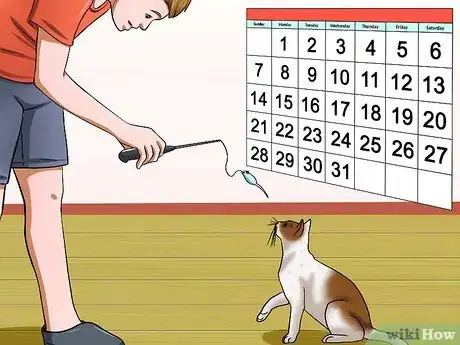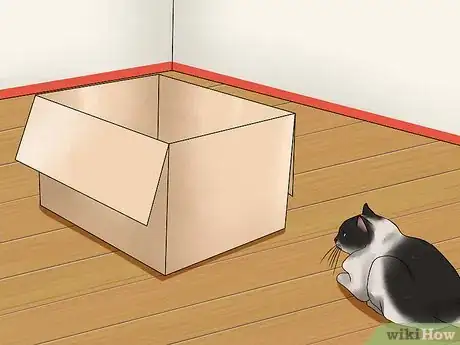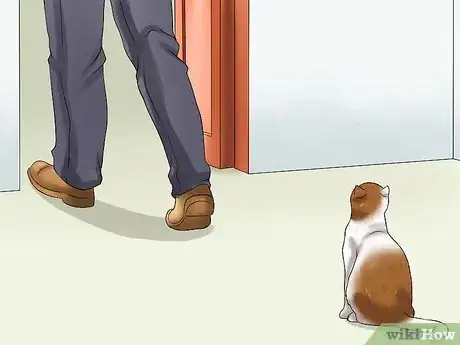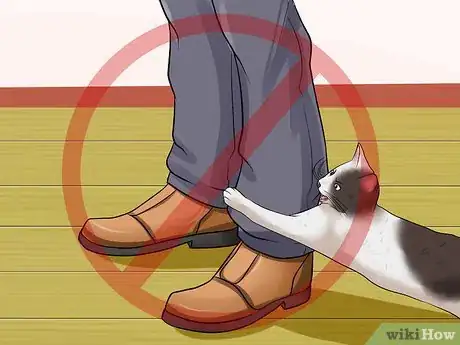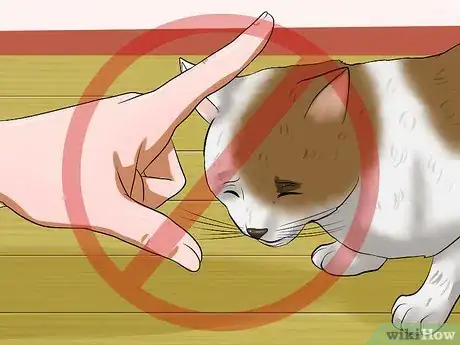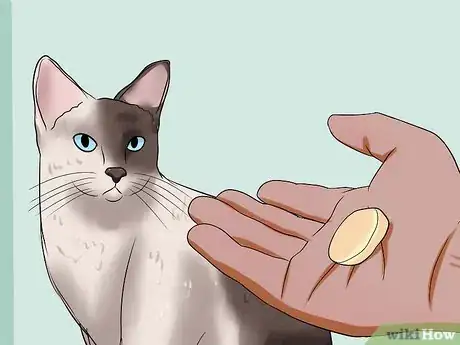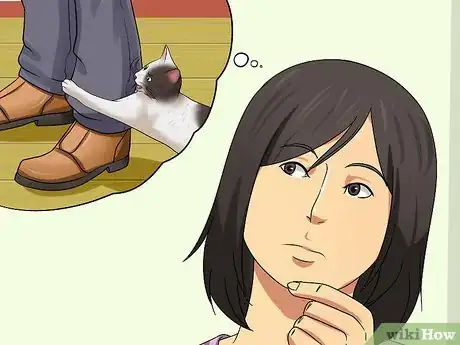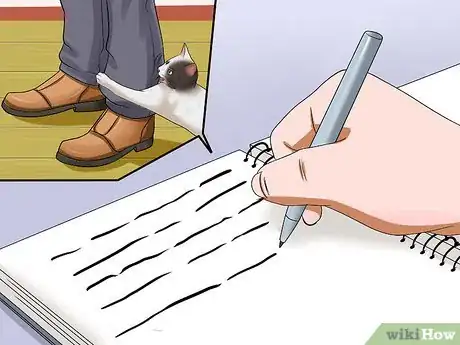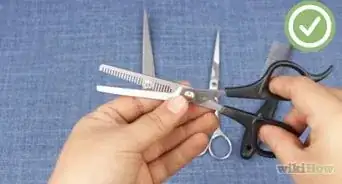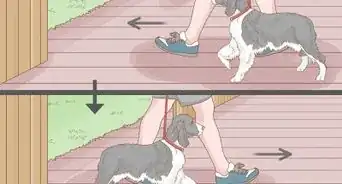This article was co-authored by Brian Bourquin, DVM. Brian Bourquin, better known as “Dr. B” to his clients, is a Veterinarian and the Owner of Boston Veterinary Clinic, a pet health care and veterinary clinic with three locations, South End/Bay Village, the Seaport, and Brookline, Massachusetts. Boston Veterinary Clinic specializes in primary veterinary care, including wellness and preventative care, sick and emergency care, soft-tissue surgery, dentistry. The clinic also provides specialty services in behavior, nutrition, and alternative pain management therapies using acupuncture, and therapeutic laser treatments. Boston Veterinary Clinic is an AAHA (American Animal Hospital Association) accredited hospital and Boston’s first Fear Free Certified Clinic. Brian has over 19 years of veterinary experience and earned his Doctor of Veterinary Medicine from Cornell University.
There are 9 references cited in this article, which can be found at the bottom of the page.
wikiHow marks an article as reader-approved once it receives enough positive feedback. In this case, 83% of readers who voted found the article helpful, earning it our reader-approved status.
This article has been viewed 508,425 times.
As much as your love your cat, she may try to attack you on occasion. She may attack because of medical or behavioral issues, but the end result is you getting bitten or scratched, which is painful and can lead to disease transmission from your cat to you.[1] If not stopped, this kind of behavior can pose a real danger to you.[2] Knowing why your cat is attacking you and what you can do to stop her from doing this will help improve your relationship and interactions with your cat.
Steps
Stopping Your Cat From Attacking You
-
1Schedule daily, interactive play sessions with your cat. The sessions should last about 10 minutes each and take place when your cat is in a playful mood. Try to schedule at least two of these sessions a day.[3] [4] Increasing the amount of time that you play with her will address one of the possible causes of her attacks, and can serve as an opportunity to teach her not to attack and/or bite you.
- A pole-type toy or a toy that dangles, both of which can be homemade or purchased at your local pet store, will keep distance between your cat and your hands and feet. This type of toy also fosters her natural predator-prey instinct.[5]
- Stuffed animal toys are helpful if your cat likes to wrestle; they are especially helpful for kittens. Select a stuffed animal toy that is about the size of your cat. If she’s getting too rough with you during playtime, rub the stuffed animal against her belly to redirect her play from you to the stuffed animal.[6]
- You can also throw one of her favorite toys away from you during playtime. Throwing the toy will serve two purposes–you are keeping her away from your hands and feet, and you are fostering her natural instinct to chase and pounce.[7]
-
2Provide her with more environmental stimulation. If you can keep your cat busy in her environment, she will probably spend less time trying to attack you. One way to increase this stimulation is to have a variety of toys and rotate them out on a regular basis.[8] It is not necessary to buy new toys on a consistent basis. You can just put out the ones you have in different combinations so that she is not always playing with the same set of toys.
- Regularly give your cat new things to explore, such as an empty cardboard box.[9]
- Provide your cat with puzzle feeders. Puzzle feeders are toys in which you can place food. Your cat will need to put in extra effort to get the food, which will keep her busy and mentally stimulated.[10]
- Place an old toy in something new, such as an empty cardboard box or paper bag.[11] This is helpful if you notice that your cat has gotten bored with some of her older toys.
- Place climbing perches or scratching posts in your cat’s favorite spots to give her something to climb and play on.[12] Cats tend to feel safer when they're up higher.[13]
- If your cat is comfortable with being outside, you could purchase or build an outdoor enclosure so that she can safely play outside.[14] Visit your local pet store to learn about the different types of outdoor enclosures that are available.
-
3Give your cat a time-out if she plays too roughly. Get up and walk out of the room, without paying her any attention, if her playing becomes too rough.[15] You can even go so far as walking to another room and closing the door, blocking her access to you.[16] Because cats avoid doing things that have a negative result,[17] taking the fun of out playtime will teach her not to play roughly with you.
- It is important that you walk away from her, rather than pick her up and move her to a different room. Your cat could interpret your physical touch as a reward, and you do not want to reward her for rough play.[18]
-
4Prevent her from attacking your ankle. When you least expect it, your cat may jump out and start biting your ankle. To your cat, your ankle is an easy moving target, especially if she does not have many other toys or objects in her environment to keep her busy. When she bites your ankle, do not try to run or pull away. Running or pulling away resembles prey behavior, and your cat’s predatory instincts will encourage her to just bite down harder.[19]
- Instead of trying to get away, gently push toward her. Because prey tend not to move toward the predator, you will confuse your cat with this action. She will let go of your ankle when she realizes that you’re not acting like prey.
- When she lets go, stay still for a moment and don’t pay her any attention.[20] She will stop biting your ankle when you take away the thrill of the catch.
-
5Set up deterrent devices in her usual stalking spots. If you have identified areas where your cat likes to hide and try to attack you, make those areas as undesirable to her as you can. There are commercially-available deterrent devices that you can use, such as upside-down mousetraps and motion-activated devices that spray compressed air.[21] These devices will startle your cat without injuring her. Eventually, she will stop returning those areas because of the startling effect and noise of those devices.[22]
- The upside-down mousetrap will flip into the air when your cat steps on it.[23]
-
6Do not punish your cat. It is very important to remember that cats do not learn by punishment (eg, yelling, hitting, tapping her on the nose). Rather, your cat will become fearful and wary of you if you punish her.[24] She may even become confused. Because the punishment would likely come after whatever she did wrong, she would not really know what she’s being punished for.
- Some cats may even see the punishment as a challenge, rather than as a deterrent.[25]
-
7Reward her for good behavior. Cats will repeat behavior that has positive consequences.[26] If you give her plenty of positive reinforcement when she does the right thing (eg, playing gently with you, snuggling with you instead of biting your hands), she will continue to do it. Keep in mind that you need to give her the positive reinforcement during her good behavior so that she will form an association between good behavior and reward.
Learning About Cat Attacks
-
1Learn why your cat is attacking you. In the wild, cats are predators. When your cat is stalking you and attacking and/or biting you, she is seeing you as prey.[27] You probably don’t see yourself as prey, since you, her owner, are bigger than she is. However, even if your cat attacks nothing more than your ankles, she is demonstrating her natural predator instincts.
- Your cat may also be attacking you because she does not have enough toys or other environmental stimulation to keep her busy. She might be bored, and sees you as an easy target.[28]
- An insufficient amount of interactive playtime can also cause her to attack.[29]
- Kittens that are separated too early from their mother and littermates do not learn how to stop biting, so they are more prone to attacking and biting you as her owner.[30] What you might see as cute behavior in a kitten can actually become a very problematic behavioral issue.
- Medical issues, such as hyperthyroidism and central nervous system dysfunction, may also be causing the attacks. Your veterinarian can determine if medical issues are the root cause.[31] Medical issues should be ruled out first before considering behavioral issues.
-
2Observe your cat’s body language. When you are playing with your cat, it may not be easy to tell the difference between normal play behavior and attack behavior (playing too roughly).[32] Your cat will give you subtle clues to let you know whether her intentions are playful or harmful. For example, if she is in a bright and playful mood, she will open her mouth halfway, pounce or hop sideways, and have an arched back; she likely won’t make much noise.[33]
- When she is approaching attack mode, she will start hissing, growling, or spitting during playtime.[34] She may also start trying to grab your hand to bite it.[35] You may see her ears flatten, pupils dilate, and tail swish back and forth.[36]
- If you are not playing with her, but notice that she is stalking you, you can be fairly confident that she’s about to try to attack you.[37]
-
3Keep a record of her attacks. Keeping a record of when your cat attacks you can help you get a better understanding of the situations and times when she is most likely to attack. For example, you may notice that she tends to bite your ankles in the morning to wake you up, or becomes aggressive each time that you play and interact with her. If you are able to anticipate when she is most likely to attack, you can do some pre-planning to try to redirect her attention from attacking you to maybe playing with a toy.[38]
Expert Q&A
-
QuestionWhy does my cat attack me when I try to pet it?
 Brian Bourquin, DVMBrian Bourquin, better known as “Dr. B” to his clients, is a Veterinarian and the Owner of Boston Veterinary Clinic, a pet health care and veterinary clinic with three locations, South End/Bay Village, the Seaport, and Brookline, Massachusetts. Boston Veterinary Clinic specializes in primary veterinary care, including wellness and preventative care, sick and emergency care, soft-tissue surgery, dentistry. The clinic also provides specialty services in behavior, nutrition, and alternative pain management therapies using acupuncture, and therapeutic laser treatments. Boston Veterinary Clinic is an AAHA (American Animal Hospital Association) accredited hospital and Boston’s first Fear Free Certified Clinic. Brian has over 19 years of veterinary experience and earned his Doctor of Veterinary Medicine from Cornell University.
Brian Bourquin, DVMBrian Bourquin, better known as “Dr. B” to his clients, is a Veterinarian and the Owner of Boston Veterinary Clinic, a pet health care and veterinary clinic with three locations, South End/Bay Village, the Seaport, and Brookline, Massachusetts. Boston Veterinary Clinic specializes in primary veterinary care, including wellness and preventative care, sick and emergency care, soft-tissue surgery, dentistry. The clinic also provides specialty services in behavior, nutrition, and alternative pain management therapies using acupuncture, and therapeutic laser treatments. Boston Veterinary Clinic is an AAHA (American Animal Hospital Association) accredited hospital and Boston’s first Fear Free Certified Clinic. Brian has over 19 years of veterinary experience and earned his Doctor of Veterinary Medicine from Cornell University.
Veterinarian Make sure you're reading your cat's signals before you try to touch it. If your cat is whipping its tail back and forth quickly or flattening its ears, it probably doesn't want to be pet right now. In general, cats don't like to be touched as much as dogs. Only pet your cat when it seems comfortable and receptive.
Make sure you're reading your cat's signals before you try to touch it. If your cat is whipping its tail back and forth quickly or flattening its ears, it probably doesn't want to be pet right now. In general, cats don't like to be touched as much as dogs. Only pet your cat when it seems comfortable and receptive. -
QuestionI bottle-fed my kitten until he was old enough to eat. He is my baby, but attacks for no reason. What can I do?
 Pippa Elliott, MRCVSDr. Elliott, BVMS, MRCVS is a veterinarian with over 30 years of experience in veterinary surgery and companion animal practice. She graduated from the University of Glasgow in 1987 with a degree in veterinary medicine and surgery. She has worked at the same animal clinic in her hometown for over 20 years.
Pippa Elliott, MRCVSDr. Elliott, BVMS, MRCVS is a veterinarian with over 30 years of experience in veterinary surgery and companion animal practice. She graduated from the University of Glasgow in 1987 with a degree in veterinary medicine and surgery. She has worked at the same animal clinic in her hometown for over 20 years.
Veterinarian This is common in hand-reared kittens, as they don't get the feedback from their littermates that they are being too rough. Try to recognize the situations when he attacks (such as when you walk past), and keep a toy in your pocket to divert his attention. When he attacks, squeal and pretend to cry (so he knows it hurts), but try to avoid moving or pulling away, as this arouses his hunting instincts and will make him attack more.
This is common in hand-reared kittens, as they don't get the feedback from their littermates that they are being too rough. Try to recognize the situations when he attacks (such as when you walk past), and keep a toy in your pocket to divert his attention. When he attacks, squeal and pretend to cry (so he knows it hurts), but try to avoid moving or pulling away, as this arouses his hunting instincts and will make him attack more. -
QuestionHow can I get my cat to stop chewing on my hair?
 Pippa Elliott, MRCVSDr. Elliott, BVMS, MRCVS is a veterinarian with over 30 years of experience in veterinary surgery and companion animal practice. She graduated from the University of Glasgow in 1987 with a degree in veterinary medicine and surgery. She has worked at the same animal clinic in her hometown for over 20 years.
Pippa Elliott, MRCVSDr. Elliott, BVMS, MRCVS is a veterinarian with over 30 years of experience in veterinary surgery and companion animal practice. She graduated from the University of Glasgow in 1987 with a degree in veterinary medicine and surgery. She has worked at the same animal clinic in her hometown for over 20 years.
Veterinarian Try blowing on her face (if you have long hair and she is within reach). Failing that, spritz her with water from a squirt bottle each time she goes for the hair.
Try blowing on her face (if you have long hair and she is within reach). Failing that, spritz her with water from a squirt bottle each time she goes for the hair.
Warnings
- Diseases that can be transmitted through cat bites and scratches, such as cat scratch fever, can make people very sick.[40] If you start to feel unwell after your cat scratches or bites you, seek immediate care from your doctor.⧼thumbs_response⧽
References
- ↑ http://www.vet.cornell.edu/fhc/health_information/brochure_aggression.cfm
- ↑ https://www.aspca.org/pet-care/virtual-pet-behaviorist/cat-behavior/aggression-cats
- ↑ http://pets.webmd.com/cats/guide/cat-aggression-biting-rough-play
- ↑ http://www.catbehaviorassociates.com/stop-your-cat-from-biting-your-ankles/
- ↑ http://www.catbehaviorassociates.com/stop-your-cat-from-biting-your-ankles/
- ↑ http://www.humanesociety.org/animals/cats/tips/kitten_play.html
- ↑ http://pets.webmd.com/cats/guide/cat-aggression-biting-rough-play
- ↑ http://www.catbehaviorassociates.com/stop-your-cat-from-biting-your-ankles/
- ↑ http://pets.webmd.com/cats/guide/cat-aggression-biting-rough-play
- ↑ http://www.catbehaviorassociates.com/stop-your-cat-from-biting-your-ankles/
- ↑ http://www.catbehaviorassociates.com/stop-your-cat-from-biting-your-ankles/
- ↑ http://www.vet.cornell.edu/fhc/health_information/brochure_aggression.cfm
- ↑ Brian Bourquin, DVM. Veterinarian. Expert Interview. 20 December 2019.
- ↑ http://pets.webmd.com/cats/guide/cat-aggression-biting-rough-play
- ↑ http://pets.webmd.com/cats/guide/cat-aggression-biting-rough-play
- ↑ http://www.humanesociety.org/animals/cats/tips/kitten_play.html
- ↑ http://www.perfectpaws.com/cat_training_and_cat_behavior.html#.VbJfFfk1NTV
- ↑ http://www.humanesociety.org/animals/cats/tips/kitten_play.html
- ↑ http://www.catbehaviorassociates.com/stop-your-cat-from-biting-your-ankles/
- ↑ http://www.catbehaviorassociates.com/stop-your-cat-from-biting-your-ankles/
- ↑ https://www.aspca.org/pet-care/virtual-pet-behaviorist/cat-behavior/keeping-your-cat-countertops-and-tables
- ↑ http://www.vet.cornell.edu/fhc/health_information/brochure_aggression.cfm
- ↑ https://www.aspca.org/pet-care/virtual-pet-behaviorist/cat-behavior/keeping-your-cat-countertops-and-tables
- ↑ Brian Bourquin, DVM. Veterinarian. Expert Interview. 20 December 2019.
- ↑ http://www.vet.cornell.edu/fhc/health_information/brochure_aggression.cfm
- ↑ Brian Bourquin, DVM. Veterinarian. Expert Interview. 20 December 2019.
- ↑ http://www.humanesociety.org/animals/cats/tips/kitten_play.html
- ↑ http://www.catbehaviorassociates.com/stop-your-cat-from-biting-your-ankles/
- ↑ http://www.catbehaviorassociates.com/stop-your-cat-from-biting-your-ankles/
- ↑ http://www.catbehaviorassociates.com/stop-your-cat-from-biting-your-ankles/
- ↑ http://www.vet.cornell.edu/fhc/health_information/brochure_aggression.cfm
- ↑ http://pets.webmd.com/cats/guide/cat-aggression-biting-rough-play
- ↑ http://pets.webmd.com/cats/guide/cat-aggression-biting-rough-play
- ↑ http://pets.webmd.com/cats/guide/cat-aggression-biting-rough-play
- ↑ https://www.aspca.org/pet-care/virtual-pet-behaviorist/cat-behavior/aggression-cats
- ↑ http://www.vet.cornell.edu/fhc/health_information/brochure_aggression.cfm
- ↑ http://www.vet.cornell.edu/fhc/health_information/brochure_aggression.cfm
- ↑ http://www.vet.cornell.edu/fhc/health_information/brochure_aggression.cfm
- ↑ http://www.vet.cornell.edu/fhc/health_information/brochure_aggression.cfm
- ↑ https://www.aspca.org/pet-care/virtual-pet-behaviorist/cat-behavior/aggression-cats
About this article
To make your cat stop attacking you, try to set aside at least two 10-minute play sessions every day since oftentimes cats attack out of boredom. Also, make sure your cat has enough environmental stimulation so it's less likely to focus on you, like toys, cardboard boxes, and scratching posts. If your cat does attack you, ignore it and leave the room, which will teach your cat that attacking equals no more attention. Don't punish or yell at your cat since cats don't understand punishment. Instead, reward your cat whenever you're playing or petting it and it doesn't attack you. To learn how to determine why your cat is attacking you in the first place, scroll down!
